Energy Consumption Analysis
Exploratory Data Analysis - EDA
In this Jupyter Notebook we will analyze the energy consumption of different sources from Spain.
Energy Consumption Analysis
Using a dataset of energy consumption in Spain, we will use statistic techniques to extract insightful information with data manipulation and visualization.
Context
In a paper released early 2019, forecasting in energy markets is identified as one of the highest leverage contribution areas of Machine/Deep Learning toward transitioning to a renewable based electrical infrastructure.
Content
This dataset contains 4 years of electrical consumption, generation, pricing, and weather data for Spain. Consumption and generation data was retrieved from ENTSOE, a public portal for Transmission Service Operator (TSO) data. Settlement prices were obtained from the Spanish TSO Red Electric España. Weather data was purchased as part of a personal project from the Open Weather API for the 5 largest cities in Spain and made public here.
Acknowledgements
This data is publicly available via ENTSOE and REE and may be found in the links above.
The Data
This is a dataset containing two files, energy_dataset.csv and the weather_features.csv.
Energy Dataset
The energy dataset contains 29 columns:
time: datetime index localized to CETgeneration biomass: generated biomass energy in MWgeneration fossil brown coal/lignite: generated coal energy in MWgeneration fossil coal-derived gas: generated coal-derived gas energy in MWgeneration fossil gas: generated natural gas energy in MWgeneration fossil hard coal: generated hard coal energy in MWgeneration fossil oil: generated conventional oil energy in MWgeneration fossil oil shale: generated unconventional oil energy in MWgeneration fossil peat: generated peat energy in MWgeneration geothermal: generated geothermal energy in MWgeneration hydro pumped storage aggregated: generated hydro pumped storage aggregated energy in MWgeneration hydro pumped storage consumption: generated hydro pumped storage consumption energy in MWgeneration hydro run-of-river and poundage: generated hydro run-of-river and poundage energy in MWgeneration hydro water reservoir: generated hydro water reservoir energy in MWgeneration marine: generated marine (wave) energy in MWgeneration nuclear: generated nuclear energy in MWgeneration other: other non-renewable sources of energy in MWgeneration other renewable: other renewable sources of energy in MWgeneration solar: generated solar energy in MWgeneration waste: generated waste energy in MWgeneration wind offshore: generated wind (offshore) energy in MWgeneration wind onshore: generated wind (onshore) energy in MWforecast solar day ahead: forecasted solar energy generationforecast wind offshore eday ahead: forecasted offshore wind generationforecast wind onshore day ahead: forecasted onshore wind generationtotal load forecast: forecasted electrical demandtotal load actual: actual electrical demandprice day ahead: forecasted price EUR/MWhprice actual: price in EUR/MWh
Weather Features
The weather datset contains 17 columns:
dt_iso: datetime index localized to CETcity_name: name of citytemp: temperature in k (Kelvin)temp_min: minimum in ktemp_max: maximum in kpressure: pressure in hPahumidity: humidity in %wind_speed: wind speed in m/swind_deg: wind directionrain_1h: rain in last hour in mmrain_3h: rain last 3 hours in mmsnow_3h: show last 3 hours in mmclouds_all: cloud cover in %weather_id: Code used to describe weatherweather_main: Short description of current weatherweather_description: Long description of current weatherweather_icon: Weather icon code for website
Data Analysis
We will simplify the data for the analysis, by combining columns and grouping by year and month.
Loading the data
# To supress warnings and deprecated messages
import warnings
warnings.filterwarnings("ignore")
# Core
import numpy as np
import pandas as pd
# Visualization
import seaborn as sns
import matplotlib.pyplot as plt
%matplotlib inline
energy = pd.read_csv("energy_dataset.csv")
energy
| time | generation biomass | generation fossil brown coal/lignite | generation fossil coal-derived gas | generation fossil gas | generation fossil hard coal | generation fossil oil | generation fossil oil shale | generation fossil peat | generation geothermal | ... | generation waste | generation wind offshore | generation wind onshore | forecast solar day ahead | forecast wind offshore eday ahead | forecast wind onshore day ahead | total load forecast | total load actual | price day ahead | price actual | |
|---|---|---|---|---|---|---|---|---|---|---|---|---|---|---|---|---|---|---|---|---|---|
| 0 | 2015-01-01 00:00:00+01:00 | 447.0 | 329.0 | 0.0 | 4844.0 | 4821.0 | 162.0 | 0.0 | 0.0 | 0.0 | ... | 196.0 | 0.0 | 6378.0 | 17.0 | NaN | 6436.0 | 26118.0 | 25385.0 | 50.10 | 65.41 |
| 1 | 2015-01-01 01:00:00+01:00 | 449.0 | 328.0 | 0.0 | 5196.0 | 4755.0 | 158.0 | 0.0 | 0.0 | 0.0 | ... | 195.0 | 0.0 | 5890.0 | 16.0 | NaN | 5856.0 | 24934.0 | 24382.0 | 48.10 | 64.92 |
| 2 | 2015-01-01 02:00:00+01:00 | 448.0 | 323.0 | 0.0 | 4857.0 | 4581.0 | 157.0 | 0.0 | 0.0 | 0.0 | ... | 196.0 | 0.0 | 5461.0 | 8.0 | NaN | 5454.0 | 23515.0 | 22734.0 | 47.33 | 64.48 |
| 3 | 2015-01-01 03:00:00+01:00 | 438.0 | 254.0 | 0.0 | 4314.0 | 4131.0 | 160.0 | 0.0 | 0.0 | 0.0 | ... | 191.0 | 0.0 | 5238.0 | 2.0 | NaN | 5151.0 | 22642.0 | 21286.0 | 42.27 | 59.32 |
| 4 | 2015-01-01 04:00:00+01:00 | 428.0 | 187.0 | 0.0 | 4130.0 | 3840.0 | 156.0 | 0.0 | 0.0 | 0.0 | ... | 189.0 | 0.0 | 4935.0 | 9.0 | NaN | 4861.0 | 21785.0 | 20264.0 | 38.41 | 56.04 |
| ... | ... | ... | ... | ... | ... | ... | ... | ... | ... | ... | ... | ... | ... | ... | ... | ... | ... | ... | ... | ... | ... |
| 35059 | 2018-12-31 19:00:00+01:00 | 297.0 | 0.0 | 0.0 | 7634.0 | 2628.0 | 178.0 | 0.0 | 0.0 | 0.0 | ... | 277.0 | 0.0 | 3113.0 | 96.0 | NaN | 3253.0 | 30619.0 | 30653.0 | 68.85 | 77.02 |
| 35060 | 2018-12-31 20:00:00+01:00 | 296.0 | 0.0 | 0.0 | 7241.0 | 2566.0 | 174.0 | 0.0 | 0.0 | 0.0 | ... | 280.0 | 0.0 | 3288.0 | 51.0 | NaN | 3353.0 | 29932.0 | 29735.0 | 68.40 | 76.16 |
| 35061 | 2018-12-31 21:00:00+01:00 | 292.0 | 0.0 | 0.0 | 7025.0 | 2422.0 | 168.0 | 0.0 | 0.0 | 0.0 | ... | 286.0 | 0.0 | 3503.0 | 36.0 | NaN | 3404.0 | 27903.0 | 28071.0 | 66.88 | 74.30 |
| 35062 | 2018-12-31 22:00:00+01:00 | 293.0 | 0.0 | 0.0 | 6562.0 | 2293.0 | 163.0 | 0.0 | 0.0 | 0.0 | ... | 287.0 | 0.0 | 3586.0 | 29.0 | NaN | 3273.0 | 25450.0 | 25801.0 | 63.93 | 69.89 |
| 35063 | 2018-12-31 23:00:00+01:00 | 290.0 | 0.0 | 0.0 | 6926.0 | 2166.0 | 163.0 | 0.0 | 0.0 | 0.0 | ... | 287.0 | 0.0 | 3651.0 | 26.0 | NaN | 3117.0 | 24424.0 | 24455.0 | 64.27 | 69.88 |
35064 rows × 29 columns
weather = pd.read_csv("weather_features.csv")
weather
| dt_iso | city_name | temp | temp_min | temp_max | pressure | humidity | wind_speed | wind_deg | rain_1h | rain_3h | snow_3h | clouds_all | weather_id | weather_main | weather_description | weather_icon | |
|---|---|---|---|---|---|---|---|---|---|---|---|---|---|---|---|---|---|
| 0 | 2015-01-01 00:00:00+01:00 | Valencia | 270.475 | 270.475 | 270.475 | 1001 | 77 | 1 | 62 | 0.0 | 0.0 | 0.0 | 0 | 800 | clear | sky is clear | 01n |
| 1 | 2015-01-01 01:00:00+01:00 | Valencia | 270.475 | 270.475 | 270.475 | 1001 | 77 | 1 | 62 | 0.0 | 0.0 | 0.0 | 0 | 800 | clear | sky is clear | 01n |
| 2 | 2015-01-01 02:00:00+01:00 | Valencia | 269.686 | 269.686 | 269.686 | 1002 | 78 | 0 | 23 | 0.0 | 0.0 | 0.0 | 0 | 800 | clear | sky is clear | 01n |
| 3 | 2015-01-01 03:00:00+01:00 | Valencia | 269.686 | 269.686 | 269.686 | 1002 | 78 | 0 | 23 | 0.0 | 0.0 | 0.0 | 0 | 800 | clear | sky is clear | 01n |
| 4 | 2015-01-01 04:00:00+01:00 | Valencia | 269.686 | 269.686 | 269.686 | 1002 | 78 | 0 | 23 | 0.0 | 0.0 | 0.0 | 0 | 800 | clear | sky is clear | 01n |
| ... | ... | ... | ... | ... | ... | ... | ... | ... | ... | ... | ... | ... | ... | ... | ... | ... | ... |
| 178391 | 2018-12-31 19:00:00+01:00 | Seville | 287.760 | 287.150 | 288.150 | 1028 | 54 | 3 | 30 | 0.0 | 0.0 | 0.0 | 0 | 800 | clear | sky is clear | 01n |
| 178392 | 2018-12-31 20:00:00+01:00 | Seville | 285.760 | 285.150 | 286.150 | 1029 | 62 | 3 | 30 | 0.0 | 0.0 | 0.0 | 0 | 800 | clear | sky is clear | 01n |
| 178393 | 2018-12-31 21:00:00+01:00 | Seville | 285.150 | 285.150 | 285.150 | 1028 | 58 | 4 | 50 | 0.0 | 0.0 | 0.0 | 0 | 800 | clear | sky is clear | 01n |
| 178394 | 2018-12-31 22:00:00+01:00 | Seville | 284.150 | 284.150 | 284.150 | 1029 | 57 | 4 | 60 | 0.0 | 0.0 | 0.0 | 0 | 800 | clear | sky is clear | 01n |
| 178395 | 2018-12-31 23:00:00+01:00 | Seville | 283.970 | 282.150 | 285.150 | 1029 | 70 | 3 | 50 | 0.0 | 0.0 | 0.0 | 0 | 800 | clear | sky is clear | 01n |
178396 rows × 17 columns
Checking data types
Using the method info:
Energy data
energy.info()
<class 'pandas.core.frame.DataFrame'>
RangeIndex: 35064 entries, 0 to 35063
Data columns (total 29 columns):
# Column Non-Null Count Dtype
--- ------ -------------- -----
0 time 35064 non-null object
1 generation biomass 35045 non-null float64
2 generation fossil brown coal/lignite 35046 non-null float64
3 generation fossil coal-derived gas 35046 non-null float64
4 generation fossil gas 35046 non-null float64
5 generation fossil hard coal 35046 non-null float64
6 generation fossil oil 35045 non-null float64
7 generation fossil oil shale 35046 non-null float64
8 generation fossil peat 35046 non-null float64
9 generation geothermal 35046 non-null float64
10 generation hydro pumped storage aggregated 0 non-null float64
11 generation hydro pumped storage consumption 35045 non-null float64
12 generation hydro run-of-river and poundage 35045 non-null float64
13 generation hydro water reservoir 35046 non-null float64
14 generation marine 35045 non-null float64
15 generation nuclear 35047 non-null float64
16 generation other 35046 non-null float64
17 generation other renewable 35046 non-null float64
18 generation solar 35046 non-null float64
19 generation waste 35045 non-null float64
20 generation wind offshore 35046 non-null float64
21 generation wind onshore 35046 non-null float64
22 forecast solar day ahead 35064 non-null float64
23 forecast wind offshore eday ahead 0 non-null float64
24 forecast wind onshore day ahead 35064 non-null float64
25 total load forecast 35064 non-null float64
26 total load actual 35028 non-null float64
27 price day ahead 35064 non-null float64
28 price actual 35064 non-null float64
dtypes: float64(28), object(1)
memory usage: 7.8+ MB
Except for the column time, which is of the object type, all the columns are of the numeric type.
We will fix the time column by converting it to datetime.
energy['time'] = pd.to_datetime(energy['time'], format='%Y-%m-%d', utc=True)
print(energy.info())
energy.head()
<class 'pandas.core.frame.DataFrame'>
RangeIndex: 35064 entries, 0 to 35063
Data columns (total 29 columns):
# Column Non-Null Count Dtype
--- ------ -------------- -----
0 time 35064 non-null datetime64[ns, UTC]
1 generation biomass 35045 non-null float64
2 generation fossil brown coal/lignite 35046 non-null float64
3 generation fossil coal-derived gas 35046 non-null float64
4 generation fossil gas 35046 non-null float64
5 generation fossil hard coal 35046 non-null float64
6 generation fossil oil 35045 non-null float64
7 generation fossil oil shale 35046 non-null float64
8 generation fossil peat 35046 non-null float64
9 generation geothermal 35046 non-null float64
10 generation hydro pumped storage aggregated 0 non-null float64
11 generation hydro pumped storage consumption 35045 non-null float64
12 generation hydro run-of-river and poundage 35045 non-null float64
13 generation hydro water reservoir 35046 non-null float64
14 generation marine 35045 non-null float64
15 generation nuclear 35047 non-null float64
16 generation other 35046 non-null float64
17 generation other renewable 35046 non-null float64
18 generation solar 35046 non-null float64
19 generation waste 35045 non-null float64
20 generation wind offshore 35046 non-null float64
21 generation wind onshore 35046 non-null float64
22 forecast solar day ahead 35064 non-null float64
23 forecast wind offshore eday ahead 0 non-null float64
24 forecast wind onshore day ahead 35064 non-null float64
25 total load forecast 35064 non-null float64
26 total load actual 35028 non-null float64
27 price day ahead 35064 non-null float64
28 price actual 35064 non-null float64
dtypes: datetime64[ns, UTC](1), float64(28)
memory usage: 7.8 MB
None
| time | generation biomass | generation fossil brown coal/lignite | generation fossil coal-derived gas | generation fossil gas | generation fossil hard coal | generation fossil oil | generation fossil oil shale | generation fossil peat | generation geothermal | ... | generation waste | generation wind offshore | generation wind onshore | forecast solar day ahead | forecast wind offshore eday ahead | forecast wind onshore day ahead | total load forecast | total load actual | price day ahead | price actual | |
|---|---|---|---|---|---|---|---|---|---|---|---|---|---|---|---|---|---|---|---|---|---|
| 0 | 2014-12-31 23:00:00+00:00 | 447.0 | 329.0 | 0.0 | 4844.0 | 4821.0 | 162.0 | 0.0 | 0.0 | 0.0 | ... | 196.0 | 0.0 | 6378.0 | 17.0 | NaN | 6436.0 | 26118.0 | 25385.0 | 50.10 | 65.41 |
| 1 | 2015-01-01 00:00:00+00:00 | 449.0 | 328.0 | 0.0 | 5196.0 | 4755.0 | 158.0 | 0.0 | 0.0 | 0.0 | ... | 195.0 | 0.0 | 5890.0 | 16.0 | NaN | 5856.0 | 24934.0 | 24382.0 | 48.10 | 64.92 |
| 2 | 2015-01-01 01:00:00+00:00 | 448.0 | 323.0 | 0.0 | 4857.0 | 4581.0 | 157.0 | 0.0 | 0.0 | 0.0 | ... | 196.0 | 0.0 | 5461.0 | 8.0 | NaN | 5454.0 | 23515.0 | 22734.0 | 47.33 | 64.48 |
| 3 | 2015-01-01 02:00:00+00:00 | 438.0 | 254.0 | 0.0 | 4314.0 | 4131.0 | 160.0 | 0.0 | 0.0 | 0.0 | ... | 191.0 | 0.0 | 5238.0 | 2.0 | NaN | 5151.0 | 22642.0 | 21286.0 | 42.27 | 59.32 |
| 4 | 2015-01-01 03:00:00+00:00 | 428.0 | 187.0 | 0.0 | 4130.0 | 3840.0 | 156.0 | 0.0 | 0.0 | 0.0 | ... | 189.0 | 0.0 | 4935.0 | 9.0 | NaN | 4861.0 | 21785.0 | 20264.0 | 38.41 | 56.04 |
5 rows × 29 columns
Weather Features
weather.info()
<class 'pandas.core.frame.DataFrame'>
RangeIndex: 178396 entries, 0 to 178395
Data columns (total 17 columns):
# Column Non-Null Count Dtype
--- ------ -------------- -----
0 dt_iso 178396 non-null object
1 city_name 178396 non-null object
2 temp 178396 non-null float64
3 temp_min 178396 non-null float64
4 temp_max 178396 non-null float64
5 pressure 178396 non-null int64
6 humidity 178396 non-null int64
7 wind_speed 178396 non-null int64
8 wind_deg 178396 non-null int64
9 rain_1h 178396 non-null float64
10 rain_3h 178396 non-null float64
11 snow_3h 178396 non-null float64
12 clouds_all 178396 non-null int64
13 weather_id 178396 non-null int64
14 weather_main 178396 non-null object
15 weather_description 178396 non-null object
16 weather_icon 178396 non-null object
dtypes: float64(6), int64(6), object(5)
memory usage: 23.1+ MB
Most of the columns are numeric. dt_iso, city_name, weather_main, weather_description, and weather_icon are of the object type. We will convert dt_iso to the datetime type and rename it as time:
weather['dt_iso'] = pd.to_datetime(weather['dt_iso'], format='%Y-%m-%d', utc=True)
weather.rename(columns={'dt_iso':'time'}, inplace=True)
print(weather.info())
weather.head()
<class 'pandas.core.frame.DataFrame'>
RangeIndex: 178396 entries, 0 to 178395
Data columns (total 17 columns):
# Column Non-Null Count Dtype
--- ------ -------------- -----
0 time 178396 non-null datetime64[ns, UTC]
1 city_name 178396 non-null object
2 temp 178396 non-null float64
3 temp_min 178396 non-null float64
4 temp_max 178396 non-null float64
5 pressure 178396 non-null int64
6 humidity 178396 non-null int64
7 wind_speed 178396 non-null int64
8 wind_deg 178396 non-null int64
9 rain_1h 178396 non-null float64
10 rain_3h 178396 non-null float64
11 snow_3h 178396 non-null float64
12 clouds_all 178396 non-null int64
13 weather_id 178396 non-null int64
14 weather_main 178396 non-null object
15 weather_description 178396 non-null object
16 weather_icon 178396 non-null object
dtypes: datetime64[ns, UTC](1), float64(6), int64(6), object(4)
memory usage: 23.1+ MB
None
| time | city_name | temp | temp_min | temp_max | pressure | humidity | wind_speed | wind_deg | rain_1h | rain_3h | snow_3h | clouds_all | weather_id | weather_main | weather_description | weather_icon | |
|---|---|---|---|---|---|---|---|---|---|---|---|---|---|---|---|---|---|
| 0 | 2014-12-31 23:00:00+00:00 | Valencia | 270.475 | 270.475 | 270.475 | 1001 | 77 | 1 | 62 | 0.0 | 0.0 | 0.0 | 0 | 800 | clear | sky is clear | 01n |
| 1 | 2015-01-01 00:00:00+00:00 | Valencia | 270.475 | 270.475 | 270.475 | 1001 | 77 | 1 | 62 | 0.0 | 0.0 | 0.0 | 0 | 800 | clear | sky is clear | 01n |
| 2 | 2015-01-01 01:00:00+00:00 | Valencia | 269.686 | 269.686 | 269.686 | 1002 | 78 | 0 | 23 | 0.0 | 0.0 | 0.0 | 0 | 800 | clear | sky is clear | 01n |
| 3 | 2015-01-01 02:00:00+00:00 | Valencia | 269.686 | 269.686 | 269.686 | 1002 | 78 | 0 | 23 | 0.0 | 0.0 | 0.0 | 0 | 800 | clear | sky is clear | 01n |
| 4 | 2015-01-01 03:00:00+00:00 | Valencia | 269.686 | 269.686 | 269.686 | 1002 | 78 | 0 | 23 | 0.0 | 0.0 | 0.0 | 0 | 800 | clear | sky is clear | 01n |
print('Date range for Energy data:')
print(energy['time'].min())
print(energy['time'].max())
Date range for Energy data:
2014-12-31 23:00:00+00:00
2018-12-31 22:00:00+00:00
print('Date range for Weather data:')
print(weather['time'].min())
print(weather['time'].max())
Date range for Weather data:
2014-12-31 23:00:00+00:00
2018-12-31 22:00:00+00:00
Both data have the same date range.
Weather
Before extracting year, month, and day from the weather dataframe, we will understand it better. How many different cities there are in the data?
print(weather['city_name'].unique())
print('Number of cities: ', weather['city_name'].nunique())
['Valencia' 'Madrid' 'Bilbao' ' Barcelona' 'Seville']
Number of cities: 5
There are 5 different cities in the data (Valencia, Madrid, Bilbao, Barcelona, Seville) meaning that the weather information are from these locations. However, the generation data (energy) contains the total energy production in Spain.
To match the structure of the files we have, we can average the weather columns (the numeric ones) over the dates and assume that they are the mean weather of Spain for that specific time.
print(energy.shape[0])
print(weather.shape[0]/5)
35064
35679.2
Apparently, at least one of the cities may have more dates than the production data.
Check, for all cities, how many rows of data they have
weather['city_name'][weather['city_name']==' Barcelona'] = 'Barcelona'
weather.groupby(weather['city_name'])['city_name'].count()
city_name
Barcelona 35476
Bilbao 35951
Madrid 36267
Seville 35557
Valencia 35145
Name: city_name, dtype: int64
Apparently, all the cities have at least slight more data than the energy production data. We need further analysis to understand the reason.
Grouping the Weather Data
Now, the next step is to average the numeric weather info for each date. So, we just need to groupby the data by time and compute the mean.
new_weather = weather.groupby(weather['time'], as_index=False).mean()
new_weather.head()
| time | temp | temp_min | temp_max | pressure | humidity | wind_speed | wind_deg | rain_1h | rain_3h | snow_3h | clouds_all | weather_id | |
|---|---|---|---|---|---|---|---|---|---|---|---|---|---|
| 0 | 2014-12-31 23:00:00+00:00 | 272.491463 | 272.491463 | 272.491463 | 1016.4 | 82.4 | 2.0 | 135.2 | 0.0 | 0.0 | 0.0 | 0.0 | 800.0 |
| 1 | 2015-01-01 00:00:00+00:00 | 272.512700 | 272.512700 | 272.512700 | 1016.2 | 82.4 | 2.0 | 135.8 | 0.0 | 0.0 | 0.0 | 0.0 | 800.0 |
| 2 | 2015-01-01 01:00:00+00:00 | 272.099137 | 272.099137 | 272.099137 | 1016.8 | 82.0 | 2.4 | 119.0 | 0.0 | 0.0 | 0.0 | 0.0 | 800.0 |
| 3 | 2015-01-01 02:00:00+00:00 | 272.089469 | 272.089469 | 272.089469 | 1016.6 | 82.0 | 2.4 | 119.2 | 0.0 | 0.0 | 0.0 | 0.0 | 800.0 |
| 4 | 2015-01-01 03:00:00+00:00 | 272.145900 | 272.145900 | 272.145900 | 1016.6 | 82.0 | 2.4 | 118.4 | 0.0 | 0.0 | 0.0 | 0.0 | 800.0 |
print(new_weather.shape[0])
print(energy.shape[0])
35064
35064
Now the number of rows is the same for both data files.
Sum columns
In this part, to make the analysis easier, let’s sum together, in the energy dataframe, the production of fossils derivative in one column, renewable in others, and so on.
First, let’s select all the column names that contain the word fossil. To extract the columns names from a dataframe:
df.columns
or
list(df)
Let’s use the second option, as we are sure that they will be extracted to a list.
cols = list(energy)
cols
['time',
'generation biomass',
'generation fossil brown coal/lignite',
'generation fossil coal-derived gas',
'generation fossil gas',
'generation fossil hard coal',
'generation fossil oil',
'generation fossil oil shale',
'generation fossil peat',
'generation geothermal',
'generation hydro pumped storage aggregated',
'generation hydro pumped storage consumption',
'generation hydro run-of-river and poundage',
'generation hydro water reservoir',
'generation marine',
'generation nuclear',
'generation other',
'generation other renewable',
'generation solar',
'generation waste',
'generation wind offshore',
'generation wind onshore',
'forecast solar day ahead',
'forecast wind offshore eday ahead',
'forecast wind onshore day ahead',
'total load forecast',
'total load actual',
'price day ahead',
'price actual']
First, let’s only select the elements of the list that contain the word generation using conditions in a list comprehension.
cols_gen = [col for col in cols if 'generation' in col]
cols_gen
['generation biomass',
'generation fossil brown coal/lignite',
'generation fossil coal-derived gas',
'generation fossil gas',
'generation fossil hard coal',
'generation fossil oil',
'generation fossil oil shale',
'generation fossil peat',
'generation geothermal',
'generation hydro pumped storage aggregated',
'generation hydro pumped storage consumption',
'generation hydro run-of-river and poundage',
'generation hydro water reservoir',
'generation marine',
'generation nuclear',
'generation other',
'generation other renewable',
'generation solar',
'generation waste',
'generation wind offshore',
'generation wind onshore']
Now we can separate the elements that contain the word fossil and the ones that don’t (which are the renewable energy).
cols_fossil = [col for col in cols_gen if 'fossil' in col]
cols_fossil
['generation fossil brown coal/lignite',
'generation fossil coal-derived gas',
'generation fossil gas',
'generation fossil hard coal',
'generation fossil oil',
'generation fossil oil shale',
'generation fossil peat']
cols_renew = [col for col in cols_gen if 'fossil' not in col]
cols_renew
['generation biomass',
'generation geothermal',
'generation hydro pumped storage aggregated',
'generation hydro pumped storage consumption',
'generation hydro run-of-river and poundage',
'generation hydro water reservoir',
'generation marine',
'generation nuclear',
'generation other',
'generation other renewable',
'generation solar',
'generation waste',
'generation wind offshore',
'generation wind onshore']
- Now we can sum these columns using the pandas method
sumwith the parameteraxis = 1. - Create a new column for fossil generation and another one for renewable generation.
- Finally drop the previous columns.
energy['fossil_generation'] = energy[cols_fossil].sum(axis=1)
energy.head()
| time | generation biomass | generation fossil brown coal/lignite | generation fossil coal-derived gas | generation fossil gas | generation fossil hard coal | generation fossil oil | generation fossil oil shale | generation fossil peat | generation geothermal | ... | generation wind offshore | generation wind onshore | forecast solar day ahead | forecast wind offshore eday ahead | forecast wind onshore day ahead | total load forecast | total load actual | price day ahead | price actual | fossil_generation | |
|---|---|---|---|---|---|---|---|---|---|---|---|---|---|---|---|---|---|---|---|---|---|
| 0 | 2014-12-31 23:00:00+00:00 | 447.0 | 329.0 | 0.0 | 4844.0 | 4821.0 | 162.0 | 0.0 | 0.0 | 0.0 | ... | 0.0 | 6378.0 | 17.0 | NaN | 6436.0 | 26118.0 | 25385.0 | 50.10 | 65.41 | 10156.0 |
| 1 | 2015-01-01 00:00:00+00:00 | 449.0 | 328.0 | 0.0 | 5196.0 | 4755.0 | 158.0 | 0.0 | 0.0 | 0.0 | ... | 0.0 | 5890.0 | 16.0 | NaN | 5856.0 | 24934.0 | 24382.0 | 48.10 | 64.92 | 10437.0 |
| 2 | 2015-01-01 01:00:00+00:00 | 448.0 | 323.0 | 0.0 | 4857.0 | 4581.0 | 157.0 | 0.0 | 0.0 | 0.0 | ... | 0.0 | 5461.0 | 8.0 | NaN | 5454.0 | 23515.0 | 22734.0 | 47.33 | 64.48 | 9918.0 |
| 3 | 2015-01-01 02:00:00+00:00 | 438.0 | 254.0 | 0.0 | 4314.0 | 4131.0 | 160.0 | 0.0 | 0.0 | 0.0 | ... | 0.0 | 5238.0 | 2.0 | NaN | 5151.0 | 22642.0 | 21286.0 | 42.27 | 59.32 | 8859.0 |
| 4 | 2015-01-01 03:00:00+00:00 | 428.0 | 187.0 | 0.0 | 4130.0 | 3840.0 | 156.0 | 0.0 | 0.0 | 0.0 | ... | 0.0 | 4935.0 | 9.0 | NaN | 4861.0 | 21785.0 | 20264.0 | 38.41 | 56.04 | 8313.0 |
5 rows × 30 columns
energy['renewable_generation'] = energy[cols_renew].sum(axis=1)
energy.head()
| time | generation biomass | generation fossil brown coal/lignite | generation fossil coal-derived gas | generation fossil gas | generation fossil hard coal | generation fossil oil | generation fossil oil shale | generation fossil peat | generation geothermal | ... | generation wind onshore | forecast solar day ahead | forecast wind offshore eday ahead | forecast wind onshore day ahead | total load forecast | total load actual | price day ahead | price actual | fossil_generation | renewable_generation | |
|---|---|---|---|---|---|---|---|---|---|---|---|---|---|---|---|---|---|---|---|---|---|
| 0 | 2014-12-31 23:00:00+00:00 | 447.0 | 329.0 | 0.0 | 4844.0 | 4821.0 | 162.0 | 0.0 | 0.0 | 0.0 | ... | 6378.0 | 17.0 | NaN | 6436.0 | 26118.0 | 25385.0 | 50.10 | 65.41 | 10156.0 | 18095.0 |
| 1 | 2015-01-01 00:00:00+00:00 | 449.0 | 328.0 | 0.0 | 5196.0 | 4755.0 | 158.0 | 0.0 | 0.0 | 0.0 | ... | 5890.0 | 16.0 | NaN | 5856.0 | 24934.0 | 24382.0 | 48.10 | 64.92 | 10437.0 | 17381.0 |
| 2 | 2015-01-01 01:00:00+00:00 | 448.0 | 323.0 | 0.0 | 4857.0 | 4581.0 | 157.0 | 0.0 | 0.0 | 0.0 | ... | 5461.0 | 8.0 | NaN | 5454.0 | 23515.0 | 22734.0 | 47.33 | 64.48 | 9918.0 | 16878.0 |
| 3 | 2015-01-01 02:00:00+00:00 | 438.0 | 254.0 | 0.0 | 4314.0 | 4131.0 | 160.0 | 0.0 | 0.0 | 0.0 | ... | 5238.0 | 2.0 | NaN | 5151.0 | 22642.0 | 21286.0 | 42.27 | 59.32 | 8859.0 | 16364.0 |
| 4 | 2015-01-01 03:00:00+00:00 | 428.0 | 187.0 | 0.0 | 4130.0 | 3840.0 | 156.0 | 0.0 | 0.0 | 0.0 | ... | 4935.0 | 9.0 | NaN | 4861.0 | 21785.0 | 20264.0 | 38.41 | 56.04 | 8313.0 | 16307.0 |
5 rows × 31 columns
Let’s also create a column with the total energy generation.
energy['total_generation'] = energy['fossil_generation'] + \
energy['renewable_generation']
energy.head()
| time | generation biomass | generation fossil brown coal/lignite | generation fossil coal-derived gas | generation fossil gas | generation fossil hard coal | generation fossil oil | generation fossil oil shale | generation fossil peat | generation geothermal | ... | forecast solar day ahead | forecast wind offshore eday ahead | forecast wind onshore day ahead | total load forecast | total load actual | price day ahead | price actual | fossil_generation | renewable_generation | total_generation | |
|---|---|---|---|---|---|---|---|---|---|---|---|---|---|---|---|---|---|---|---|---|---|
| 0 | 2014-12-31 23:00:00+00:00 | 447.0 | 329.0 | 0.0 | 4844.0 | 4821.0 | 162.0 | 0.0 | 0.0 | 0.0 | ... | 17.0 | NaN | 6436.0 | 26118.0 | 25385.0 | 50.10 | 65.41 | 10156.0 | 18095.0 | 28251.0 |
| 1 | 2015-01-01 00:00:00+00:00 | 449.0 | 328.0 | 0.0 | 5196.0 | 4755.0 | 158.0 | 0.0 | 0.0 | 0.0 | ... | 16.0 | NaN | 5856.0 | 24934.0 | 24382.0 | 48.10 | 64.92 | 10437.0 | 17381.0 | 27818.0 |
| 2 | 2015-01-01 01:00:00+00:00 | 448.0 | 323.0 | 0.0 | 4857.0 | 4581.0 | 157.0 | 0.0 | 0.0 | 0.0 | ... | 8.0 | NaN | 5454.0 | 23515.0 | 22734.0 | 47.33 | 64.48 | 9918.0 | 16878.0 | 26796.0 |
| 3 | 2015-01-01 02:00:00+00:00 | 438.0 | 254.0 | 0.0 | 4314.0 | 4131.0 | 160.0 | 0.0 | 0.0 | 0.0 | ... | 2.0 | NaN | 5151.0 | 22642.0 | 21286.0 | 42.27 | 59.32 | 8859.0 | 16364.0 | 25223.0 |
| 4 | 2015-01-01 03:00:00+00:00 | 428.0 | 187.0 | 0.0 | 4130.0 | 3840.0 | 156.0 | 0.0 | 0.0 | 0.0 | ... | 9.0 | NaN | 4861.0 | 21785.0 | 20264.0 | 38.41 | 56.04 | 8313.0 | 16307.0 | 24620.0 |
5 rows × 32 columns
Now that we have the summarized columns, we can drop the generation ones:
energy.drop(columns = cols_gen, inplace=True)
energy.head()
| time | forecast solar day ahead | forecast wind offshore eday ahead | forecast wind onshore day ahead | total load forecast | total load actual | price day ahead | price actual | fossil_generation | renewable_generation | total_generation | |
|---|---|---|---|---|---|---|---|---|---|---|---|
| 0 | 2014-12-31 23:00:00+00:00 | 17.0 | NaN | 6436.0 | 26118.0 | 25385.0 | 50.10 | 65.41 | 10156.0 | 18095.0 | 28251.0 |
| 1 | 2015-01-01 00:00:00+00:00 | 16.0 | NaN | 5856.0 | 24934.0 | 24382.0 | 48.10 | 64.92 | 10437.0 | 17381.0 | 27818.0 |
| 2 | 2015-01-01 01:00:00+00:00 | 8.0 | NaN | 5454.0 | 23515.0 | 22734.0 | 47.33 | 64.48 | 9918.0 | 16878.0 | 26796.0 |
| 3 | 2015-01-01 02:00:00+00:00 | 2.0 | NaN | 5151.0 | 22642.0 | 21286.0 | 42.27 | 59.32 | 8859.0 | 16364.0 | 25223.0 |
| 4 | 2015-01-01 03:00:00+00:00 | 9.0 | NaN | 4861.0 | 21785.0 | 20264.0 | 38.41 | 56.04 | 8313.0 | 16307.0 | 24620.0 |
Let’s also drop the forecast columns as we are not doing any modeling to compare.
cols_forecast = [col for col in list(energy) if 'forecast' in col]
cols_forecast
['forecast solar day ahead',
'forecast wind offshore eday ahead',
'forecast wind onshore day ahead',
'total load forecast']
energy.drop(columns=cols_forecast, inplace=True)
energy.head()
| time | total load actual | price day ahead | price actual | fossil_generation | renewable_generation | total_generation | |
|---|---|---|---|---|---|---|---|
| 0 | 2014-12-31 23:00:00+00:00 | 25385.0 | 50.10 | 65.41 | 10156.0 | 18095.0 | 28251.0 |
| 1 | 2015-01-01 00:00:00+00:00 | 24382.0 | 48.10 | 64.92 | 10437.0 | 17381.0 | 27818.0 |
| 2 | 2015-01-01 01:00:00+00:00 | 22734.0 | 47.33 | 64.48 | 9918.0 | 16878.0 | 26796.0 |
| 3 | 2015-01-01 02:00:00+00:00 | 21286.0 | 42.27 | 59.32 | 8859.0 | 16364.0 | 25223.0 |
| 4 | 2015-01-01 03:00:00+00:00 | 20264.0 | 38.41 | 56.04 | 8313.0 | 16307.0 | 24620.0 |
Drop weather_id column
new_weather.drop(columns=['weather_id'], inplace=True)
new_weather.head()
| time | temp | temp_min | temp_max | pressure | humidity | wind_speed | wind_deg | rain_1h | rain_3h | snow_3h | clouds_all | |
|---|---|---|---|---|---|---|---|---|---|---|---|---|
| 0 | 2014-12-31 23:00:00+00:00 | 272.491463 | 272.491463 | 272.491463 | 1016.4 | 82.4 | 2.0 | 135.2 | 0.0 | 0.0 | 0.0 | 0.0 |
| 1 | 2015-01-01 00:00:00+00:00 | 272.512700 | 272.512700 | 272.512700 | 1016.2 | 82.4 | 2.0 | 135.8 | 0.0 | 0.0 | 0.0 | 0.0 |
| 2 | 2015-01-01 01:00:00+00:00 | 272.099137 | 272.099137 | 272.099137 | 1016.8 | 82.0 | 2.4 | 119.0 | 0.0 | 0.0 | 0.0 | 0.0 |
| 3 | 2015-01-01 02:00:00+00:00 | 272.089469 | 272.089469 | 272.089469 | 1016.6 | 82.0 | 2.4 | 119.2 | 0.0 | 0.0 | 0.0 | 0.0 |
| 4 | 2015-01-01 03:00:00+00:00 | 272.145900 | 272.145900 | 272.145900 | 1016.6 | 82.0 | 2.4 | 118.4 | 0.0 | 0.0 | 0.0 | 0.0 |
Merging Dataframes
Merging dataframes on time.
data = energy.merge(new_weather, on='time', how='inner')
data
| time | total load actual | price day ahead | price actual | fossil_generation | renewable_generation | total_generation | temp | temp_min | temp_max | pressure | humidity | wind_speed | wind_deg | rain_1h | rain_3h | snow_3h | clouds_all | |
|---|---|---|---|---|---|---|---|---|---|---|---|---|---|---|---|---|---|---|
| 0 | 2014-12-31 23:00:00+00:00 | 25385.0 | 50.10 | 65.41 | 10156.0 | 18095.0 | 28251.0 | 272.491463 | 272.491463 | 272.491463 | 1016.4 | 82.4 | 2.0 | 135.2 | 0.0 | 0.0 | 0.0 | 0.0 |
| 1 | 2015-01-01 00:00:00+00:00 | 24382.0 | 48.10 | 64.92 | 10437.0 | 17381.0 | 27818.0 | 272.512700 | 272.512700 | 272.512700 | 1016.2 | 82.4 | 2.0 | 135.8 | 0.0 | 0.0 | 0.0 | 0.0 |
| 2 | 2015-01-01 01:00:00+00:00 | 22734.0 | 47.33 | 64.48 | 9918.0 | 16878.0 | 26796.0 | 272.099137 | 272.099137 | 272.099137 | 1016.8 | 82.0 | 2.4 | 119.0 | 0.0 | 0.0 | 0.0 | 0.0 |
| 3 | 2015-01-01 02:00:00+00:00 | 21286.0 | 42.27 | 59.32 | 8859.0 | 16364.0 | 25223.0 | 272.089469 | 272.089469 | 272.089469 | 1016.6 | 82.0 | 2.4 | 119.2 | 0.0 | 0.0 | 0.0 | 0.0 |
| 4 | 2015-01-01 03:00:00+00:00 | 20264.0 | 38.41 | 56.04 | 8313.0 | 16307.0 | 24620.0 | 272.145900 | 272.145900 | 272.145900 | 1016.6 | 82.0 | 2.4 | 118.4 | 0.0 | 0.0 | 0.0 | 0.0 |
| ... | ... | ... | ... | ... | ... | ... | ... | ... | ... | ... | ... | ... | ... | ... | ... | ... | ... | ... |
| 35059 | 2018-12-31 18:00:00+00:00 | 30653.0 | 68.85 | 77.02 | 10440.0 | 15975.0 | 26415.0 | 284.470000 | 283.350000 | 285.550000 | 1029.2 | 73.6 | 1.4 | 151.4 | 0.0 | 0.0 | 0.0 | 0.0 |
| 35060 | 2018-12-31 19:00:00+00:00 | 29735.0 | 68.40 | 76.16 | 9981.0 | 15232.0 | 25213.0 | 282.294000 | 280.950000 | 283.350000 | 1030.0 | 68.0 | 1.8 | 160.4 | 0.0 | 0.0 | 0.0 | 0.0 |
| 35061 | 2018-12-31 20:00:00+00:00 | 28071.0 | 66.88 | 74.30 | 9615.0 | 14372.0 | 23987.0 | 280.850000 | 280.350000 | 281.350000 | 1029.8 | 71.4 | 2.6 | 226.0 | 0.0 | 0.0 | 0.0 | 0.0 |
| 35062 | 2018-12-31 21:00:00+00:00 | 25801.0 | 63.93 | 69.89 | 9018.0 | 13730.0 | 22748.0 | 279.718000 | 278.750000 | 280.750000 | 1030.2 | 70.0 | 2.8 | 230.0 | 0.0 | 0.0 | 0.0 | 0.0 |
| 35063 | 2018-12-31 22:00:00+00:00 | 24455.0 | 64.27 | 69.88 | 9255.0 | 13350.0 | 22605.0 | 278.798000 | 277.550000 | 279.950000 | 1030.2 | 82.4 | 2.6 | 224.0 | 0.0 | 0.0 | 0.0 | 0.0 |
35064 rows × 18 columns
Now we have a new dataframe with 35064 rows and 21 columns.
Extracting year and month from date columns
After we converted the dates from object to datetime, now we can use methods inside Pandas to get the year, the month and add them to new columns.
Data
data['year'] = data['time'].dt.year
data['month'] = data['time'].dt.month_name()
data.loc[:3,['year', 'month']]
| year | month | |
|---|---|---|
| 0 | 2014 | December |
| 1 | 2015 | January |
| 2 | 2015 | January |
| 3 | 2015 | January |
Checking for duplicated rows
data.duplicated().sum()
0
Grouping the data
This analysis can be simplified by averaging the columns by year/month.
data_month = data.groupby(['year', 'month'], as_index=False).mean()
data_month.head()
| year | month | total load actual | price day ahead | price actual | fossil_generation | renewable_generation | total_generation | temp | temp_min | temp_max | pressure | humidity | wind_speed | wind_deg | rain_1h | rain_3h | snow_3h | clouds_all | |
|---|---|---|---|---|---|---|---|---|---|---|---|---|---|---|---|---|---|---|---|
| 0 | 2014 | December | 25385.000000 | 50.100000 | 65.410000 | 10156.000000 | 18095.000000 | 28251.000000 | 272.491463 | 272.491463 | 272.491463 | 1016.400000 | 82.400000 | 2.000000 | 135.200000 | 0.000000 | 0.000000e+00 | 0.000000 | 0.000000 |
| 1 | 2015 | April | 27438.268156 | 48.900778 | 58.402806 | 10544.502778 | 17737.369444 | 28281.872222 | 287.221759 | 287.221759 | 287.221759 | 1014.331111 | 69.419167 | 2.287778 | 162.444444 | 0.119417 | 2.966667e-03 | 0.000000 | 33.368056 |
| 2 | 2015 | August | 27723.881720 | 52.767984 | 64.022231 | 11684.162634 | 17178.002688 | 28862.165323 | 298.509490 | 295.351299 | 301.929703 | 1015.289126 | 59.527311 | 2.648637 | 170.447798 | 0.064443 | 5.376344e-07 | 0.000000 | 20.297888 |
| 3 | 2015 | December | 27656.080754 | 50.335766 | 61.881895 | 11188.764785 | 16619.870968 | 27808.635753 | 284.339451 | 283.042610 | 285.839638 | 1028.561559 | 75.803175 | 1.915931 | 166.347683 | 0.017137 | 5.653226e-04 | 0.000000 | 20.615854 |
| 4 | 2015 | February | 29478.727685 | 44.206295 | 56.412991 | 9355.761905 | 22093.273810 | 31449.035714 | 281.200904 | 281.145523 | 281.275672 | 3822.709524 | 71.226786 | 3.528274 | 208.155060 | 0.233661 | 0.000000e+00 | 0.215982 | 38.500000 |
Now we reduced the data to 48 rows.
Note that the first row, for December 2014, comes from the average of a single day. Let’s remove it.
data_month.drop(0, axis=0, inplace=True) # Dropping first row
data_month.reset_index(inplace=True, drop=True) # Reseting indexes
data_month.head()
| year | month | total load actual | price day ahead | price actual | fossil_generation | renewable_generation | total_generation | temp | temp_min | temp_max | pressure | humidity | wind_speed | wind_deg | rain_1h | rain_3h | snow_3h | clouds_all | |
|---|---|---|---|---|---|---|---|---|---|---|---|---|---|---|---|---|---|---|---|
| 0 | 2015 | April | 27438.268156 | 48.900778 | 58.402806 | 10544.502778 | 17737.369444 | 28281.872222 | 287.221759 | 287.221759 | 287.221759 | 1014.331111 | 69.419167 | 2.287778 | 162.444444 | 0.119417 | 2.966667e-03 | 0.000000 | 33.368056 |
| 1 | 2015 | August | 27723.881720 | 52.767984 | 64.022231 | 11684.162634 | 17178.002688 | 28862.165323 | 298.509490 | 295.351299 | 301.929703 | 1015.289126 | 59.527311 | 2.648637 | 170.447798 | 0.064443 | 5.376344e-07 | 0.000000 | 20.297888 |
| 2 | 2015 | December | 27656.080754 | 50.335766 | 61.881895 | 11188.764785 | 16619.870968 | 27808.635753 | 284.339451 | 283.042610 | 285.839638 | 1028.561559 | 75.803175 | 1.915931 | 166.347683 | 0.017137 | 5.653226e-04 | 0.000000 | 20.615854 |
| 3 | 2015 | February | 29478.727685 | 44.206295 | 56.412991 | 9355.761905 | 22093.273810 | 31449.035714 | 281.200904 | 281.145523 | 281.275672 | 3822.709524 | 71.226786 | 3.528274 | 208.155060 | 0.233661 | 0.000000e+00 | 0.215982 | 38.500000 |
| 4 | 2015 | January | 29997.428765 | 47.419395 | 64.898763 | 10975.498656 | 20265.599462 | 31241.098118 | 280.161853 | 280.161853 | 280.161853 | 1011.519848 | 74.269220 | 2.773566 | 208.266711 | 0.140726 | 2.419355e-04 | 0.019456 | 26.796057 |
Now we have the data ready for plotting.
Data Visualization
We organized our data and now we can start the visualization step.
Let’s start by checking the columns statistics.
data_month.describe().T
| count | mean | std | min | 25% | 50% | 75% | max | |
|---|---|---|---|---|---|---|---|---|
| year | 48.0 | 2016.500000 | 1.129865 | 2015.000000 | 2015.750000 | 2016.500000 | 2017.250000 | 2018.000000 |
| total load actual | 48.0 | 28701.324430 | 930.483892 | 27068.497222 | 27979.676600 | 28757.848790 | 29439.689695 | 30508.004032 |
| price day ahead | 48.0 | 49.856492 | 8.564444 | 31.183042 | 46.299614 | 50.740506 | 54.765082 | 66.797167 |
| price actual | 48.0 | 57.861657 | 10.320096 | 32.608194 | 51.526020 | 59.603322 | 64.943411 | 79.505524 |
| fossil_generation | 48.0 | 10616.019117 | 1786.559628 | 6895.573611 | 9469.786559 | 10689.189516 | 11874.556967 | 15000.159722 |
| renewable_generation | 48.0 | 18013.033975 | 1898.831184 | 15066.966667 | 16701.720833 | 17650.509702 | 19110.867944 | 23622.677419 |
| total_generation | 48.0 | 28629.053091 | 1290.822528 | 26572.448611 | 27759.122984 | 28321.575605 | 29384.842545 | 31542.150538 |
| temp | 48.0 | 289.640068 | 6.183956 | 280.161853 | 284.305202 | 289.135518 | 295.726926 | 300.382456 |
| temp_min | 48.0 | 288.359164 | 5.964690 | 278.979017 | 283.245527 | 287.637851 | 293.587372 | 298.372781 |
| temp_max | 48.0 | 291.104105 | 6.482340 | 280.161853 | 285.585002 | 290.259110 | 297.119886 | 303.429085 |
| pressure | 48.0 | 1074.874655 | 405.089653 | 998.742742 | 1014.127211 | 1015.888361 | 1019.347961 | 3822.709524 |
| humidity | 48.0 | 68.238709 | 7.100903 | 55.703313 | 61.914662 | 68.592803 | 73.407268 | 82.455741 |
| wind_speed | 48.0 | 2.470812 | 0.492745 | 1.623118 | 2.202493 | 2.384306 | 2.623697 | 4.126827 |
| wind_deg | 48.0 | 166.722118 | 18.077149 | 122.671013 | 156.652464 | 166.047431 | 172.275942 | 209.786258 |
| rain_1h | 48.0 | 0.073568 | 0.067199 | 0.011290 | 0.030858 | 0.058919 | 0.086169 | 0.350887 |
| rain_3h | 48.0 | 0.000384 | 0.000798 | 0.000000 | 0.000000 | 0.000013 | 0.000401 | 0.003648 |
| snow_3h | 48.0 | 0.005195 | 0.031248 | 0.000000 | 0.000000 | 0.000000 | 0.000000 | 0.215982 |
| clouds_all | 48.0 | 24.794366 | 6.288097 | 16.672670 | 19.359981 | 23.646221 | 29.367044 | 38.500000 |
- Data goes from 2015 to 2018
- Mean and median of all columns seem to have close values, suggesting a symmetric distribution
Checking data distribution
Distribution of the features can be checked with the boxplot and histograms.
Fossil Energy
plt.figure(figsize=(10,3))
sns.boxplot(data=data_month, x='fossil_generation');

plt.figure(figsize=(10,5))
sns.histplot(data=data_month, x='fossil_generation', bins=10);

For the fossil energy production, the distribution is close fo normal with no outliers.
A first comment is that we will keep using the boxplot and the histogram for all the features. To make it easier, let’s create a function to help us.
def hist_box(data, feature, figsize=(12, 7)):
# Subplot canvas
fig, (ax_box, ax_hist) = plt.subplots(nrows=2, sharex=True,
gridspec_kw={"height_ratios": (0.25, 0.75)}, figsize=figsize)
# Boxplot on top
# boxplot will be created and a triangle will indicate the mean value of the column
sns.boxplot(data=data, x=feature, ax=ax_box, showmeans=True, color="pink")
# Histogram on bottom
# histogram will be created
sns.histplot(data=data, x=feature, ax=ax_hist)
# Add mean and median to histogram
ax_hist.axvline(data[feature].mean(), color="green") # mean
ax_hist.axvline(data[feature].median(), color="orange") # median
# Title
fig.suptitle("Distribution of " + feature, fontsize=16)
hist_box(data_month, "fossil_generation")
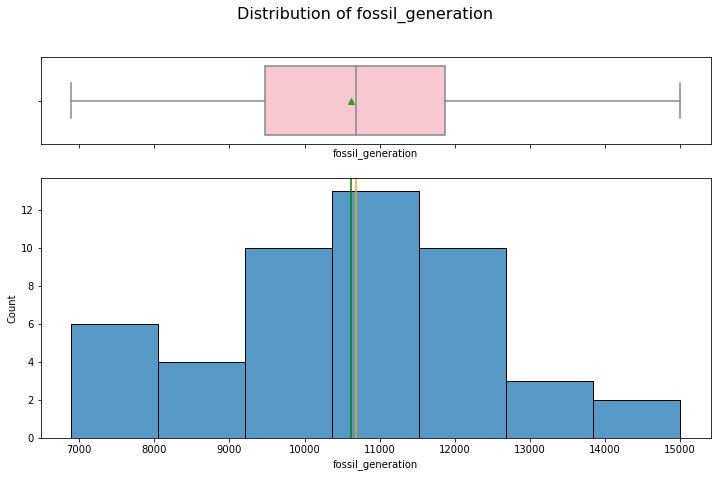
We can confirm that the mean (green) and and median (orange) are close to each other.
Renewable Energy
hist_box(data_month, "renewable_generation")
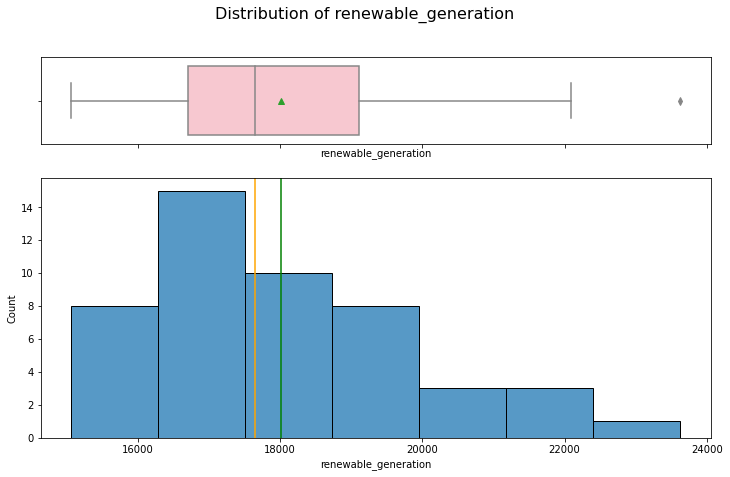
The distribution is right skewed with outliers.
# Filtering data for outlier
data_month[data_month["renewable_generation"] > 23000]
| year | month | total load actual | price day ahead | price actual | fossil_generation | renewable_generation | total_generation | temp | temp_min | temp_max | pressure | humidity | wind_speed | wind_deg | rain_1h | rain_3h | snow_3h | clouds_all | |
|---|---|---|---|---|---|---|---|---|---|---|---|---|---|---|---|---|---|---|---|
| 43 | 2018 | March | 29434.467742 | 44.802433 | 48.260013 | 7502.173387 | 23622.677419 | 31124.850806 | 284.202454 | 283.313167 | 285.14394 | 1007.586145 | 68.337927 | 4.126827 | 209.786258 | 0.120227 | 0.000018 | 0.0 | 33.891644 |
March 2018 is shown as an outlier, with a higher average renewable energy generation.
Total Energy
hist_box(data_month, "total_generation")
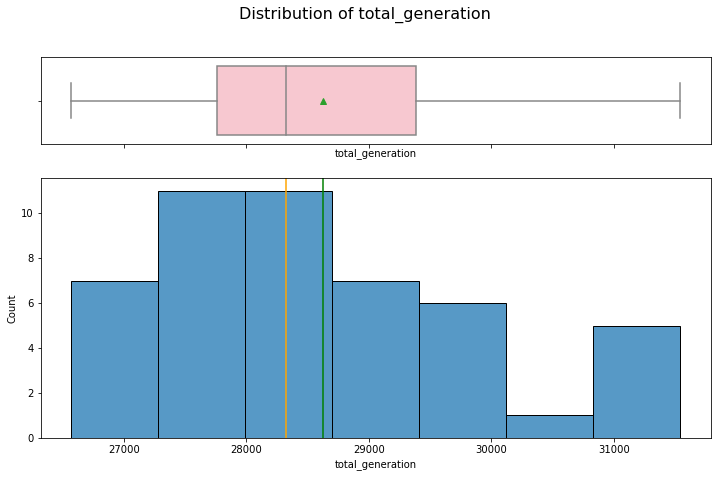
The distribution is right skewed with no outliers.
Total Load
hist_box(data_month, "total load actual")
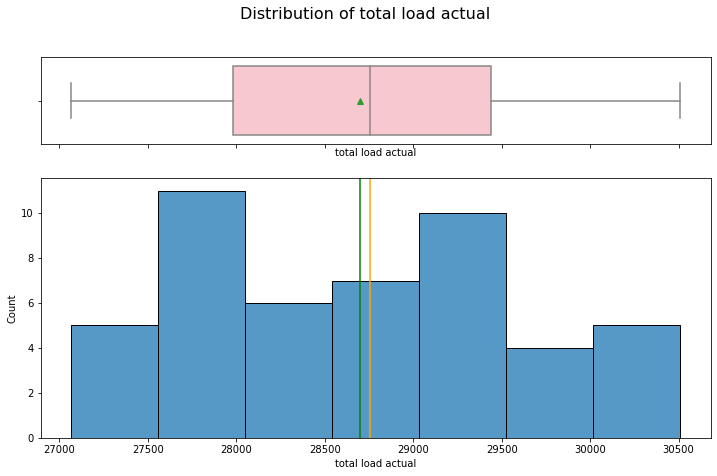
The total usage of all types of energy has a symmetric distribution.
Temperature
Temp
hist_box(data_month, "temp")
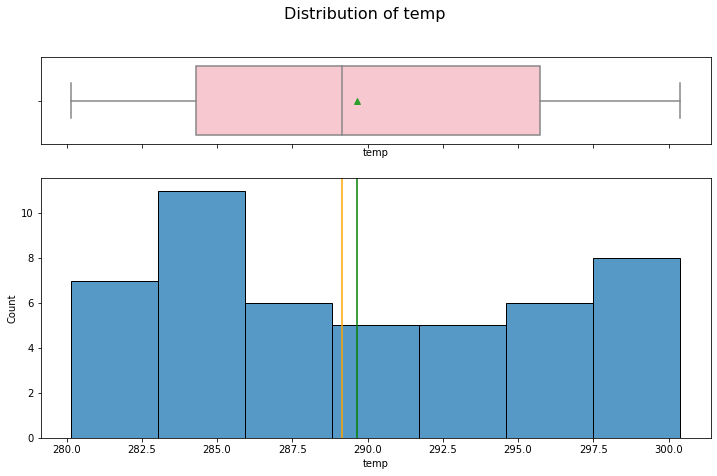
Temperature seems to be bi-modal (two peaks). Probably Summer and Winter effects.
Min and max temperatures
hist_box(data_month, "temp_min")
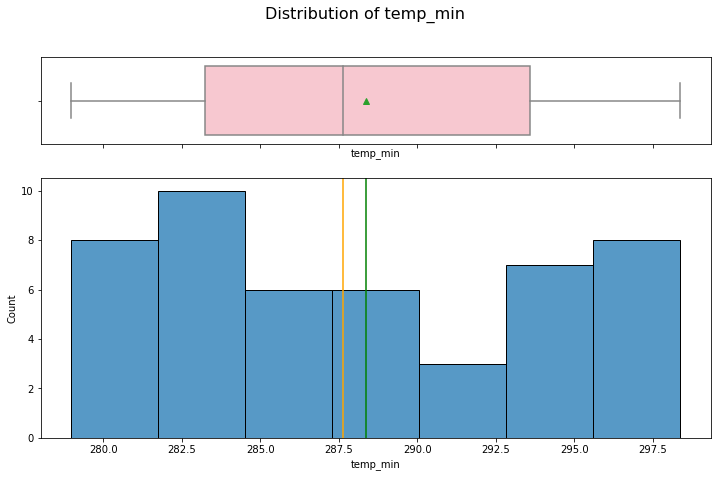
hist_box(data_month, "temp_max")
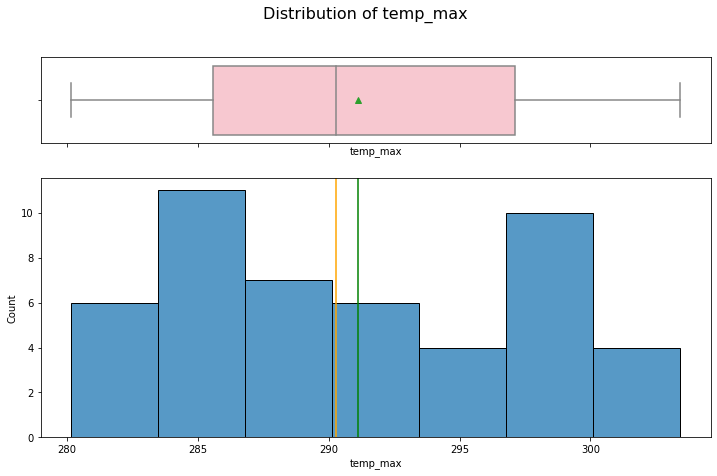
Same observation as temp.
Pressure
hist_box(data_month, "pressure")
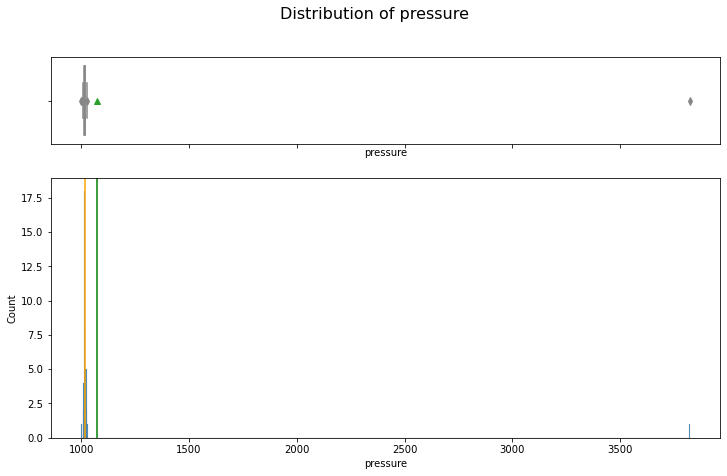
Pressure has a huge outlier. Let’s look at it closer.
data_month[data_month['pressure'] > 1500]
| year | month | total load actual | price day ahead | price actual | fossil_generation | renewable_generation | total_generation | temp | temp_min | temp_max | pressure | humidity | wind_speed | wind_deg | rain_1h | rain_3h | snow_3h | clouds_all | |
|---|---|---|---|---|---|---|---|---|---|---|---|---|---|---|---|---|---|---|---|
| 3 | 2015 | February | 29478.727685 | 44.206295 | 56.412991 | 9355.761905 | 22093.27381 | 31449.035714 | 281.200904 | 281.145523 | 281.275672 | 3822.709524 | 71.226786 | 3.528274 | 208.15506 | 0.233661 | 0.0 | 0.215982 | 38.5 |
February 2015 is the outlier for pressure, with an average pressure more than 3 times larger than any other month, pointing to something wrong. We can’t check which day, but we can replace the value with the average for the month of February:
data_month.loc[3, 'pressure'] = data_month[(data_month['month'] == 'February') & (data_month['year'] != 2015)]['pressure'].mean()
hist_box(data_month, "pressure")
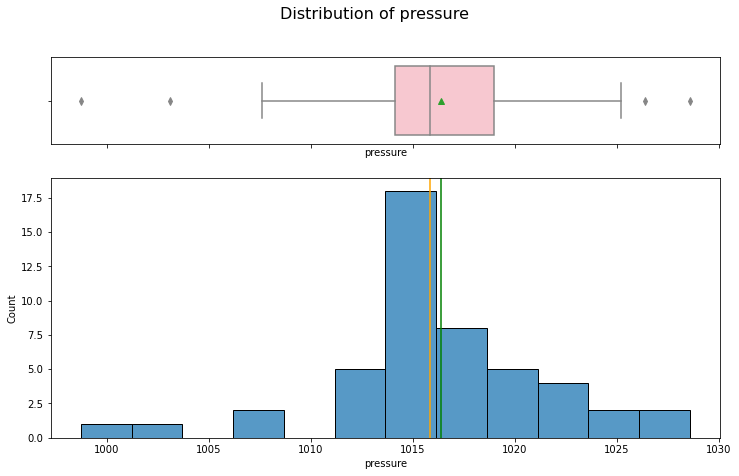
The distribution for the pressure is right skewed with outliers that are now, apparently, possible to happen.
Humidity
hist_box(data_month, "humidity")
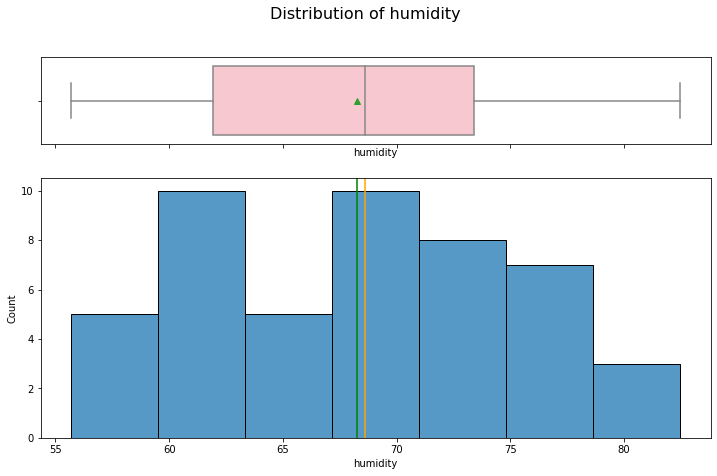
Humidity has a symmetric distribution with no outliers.
Wind
Wind Speed
hist_box(data_month, "wind_speed")
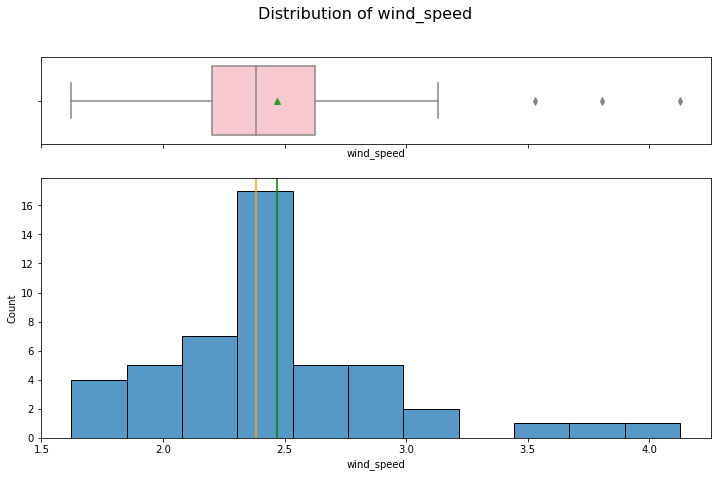
A right skewed distribution with outliers over 3.2.
data_month[data_month["wind_speed"] > 3.2]
| year | month | total load actual | price day ahead | price actual | fossil_generation | renewable_generation | total_generation | temp | temp_min | temp_max | pressure | humidity | wind_speed | wind_deg | rain_1h | rain_3h | snow_3h | clouds_all | |
|---|---|---|---|---|---|---|---|---|---|---|---|---|---|---|---|---|---|---|---|
| 3 | 2015 | February | 29478.727685 | 44.206295 | 56.412991 | 9355.761905 | 22093.273810 | 31449.035714 | 281.200904 | 281.145523 | 281.275672 | 1015.109317 | 71.226786 | 3.528274 | 208.155060 | 0.233661 | 0.000000 | 0.215982 | 38.500000 |
| 15 | 2016 | February | 29274.227011 | 31.431897 | 36.732601 | 7968.311782 | 21615.405172 | 29583.716954 | 283.927434 | 282.761944 | 285.371025 | 1018.282916 | 70.140852 | 3.804098 | 205.579687 | 0.067562 | 0.000309 | 0.000779 | 29.264915 |
| 43 | 2018 | March | 29434.467742 | 44.802433 | 48.260013 | 7502.173387 | 23622.677419 | 31124.850806 | 284.202454 | 283.313167 | 285.143940 | 1007.586145 | 68.337927 | 4.126827 | 209.786258 | 0.120227 | 0.000018 | 0.000000 | 33.891644 |
These outliers are from months with higher production on renewable energy, probably driven by the wind power.
Wind Direction
hist_box(data_month, "wind_deg")
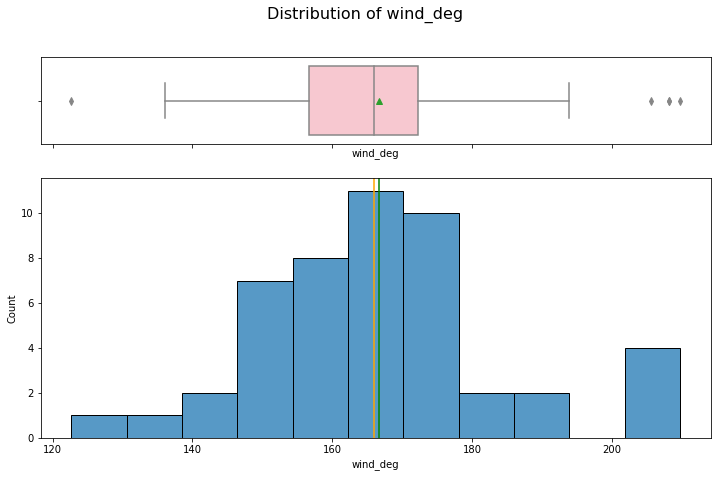
Wind direction has a close to normal distribution with outliers.
data_month[data_month["wind_deg"] > 190]
| year | month | total load actual | price day ahead | price actual | fossil_generation | renewable_generation | total_generation | temp | temp_min | temp_max | pressure | humidity | wind_speed | wind_deg | rain_1h | rain_3h | snow_3h | clouds_all | |
|---|---|---|---|---|---|---|---|---|---|---|---|---|---|---|---|---|---|---|---|
| 3 | 2015 | February | 29478.727685 | 44.206295 | 56.412991 | 9355.761905 | 22093.273810 | 31449.035714 | 281.200904 | 281.145523 | 281.275672 | 1015.109317 | 71.226786 | 3.528274 | 208.155060 | 0.233661 | 0.000000 | 0.215982 | 38.500000 |
| 4 | 2015 | January | 29997.428765 | 47.419395 | 64.898763 | 10975.498656 | 20265.599462 | 31241.098118 | 280.161853 | 280.161853 | 280.161853 | 1011.519848 | 74.269220 | 2.773566 | 208.266711 | 0.140726 | 0.000242 | 0.019456 | 26.796057 |
| 15 | 2016 | February | 29274.227011 | 31.431897 | 36.732601 | 7968.311782 | 21615.405172 | 29583.716954 | 283.927434 | 282.761944 | 285.371025 | 1018.282916 | 70.140852 | 3.804098 | 205.579687 | 0.067562 | 0.000309 | 0.000779 | 29.264915 |
| 16 | 2016 | January | 29309.133065 | 41.462016 | 45.562594 | 10227.041667 | 19091.509409 | 29318.551075 | 284.129075 | 282.928775 | 285.545507 | 1020.828479 | 75.343255 | 3.129423 | 190.388003 | 0.053508 | 0.000800 | 0.000000 | 33.686744 |
| 19 | 2016 | March | 28014.223118 | 33.255121 | 36.806882 | 7784.805108 | 20797.026882 | 28581.831989 | 284.688246 | 283.555722 | 286.258105 | 1015.590751 | 67.571646 | 2.923739 | 193.838191 | 0.060453 | 0.000460 | 0.000429 | 27.978136 |
| 43 | 2018 | March | 29434.467742 | 44.802433 | 48.260013 | 7502.173387 | 23622.677419 | 31124.850806 | 284.202454 | 283.313167 | 285.143940 | 1007.586145 | 68.337927 | 4.126827 | 209.786258 | 0.120227 | 0.000018 | 0.000000 | 33.891644 |
data_month[data_month["wind_deg"] < 130]
| year | month | total load actual | price day ahead | price actual | fossil_generation | renewable_generation | total_generation | temp | temp_min | temp_max | pressure | humidity | wind_speed | wind_deg | rain_1h | rain_3h | snow_3h | clouds_all | |
|---|---|---|---|---|---|---|---|---|---|---|---|---|---|---|---|---|---|---|---|
| 14 | 2016 | December | 28935.895161 | 52.637527 | 67.601304 | 12118.568548 | 16562.985215 | 28681.553763 | 283.366049 | 281.471074 | 285.822994 | 1026.353176 | 82.455741 | 1.809381 | 122.671013 | 0.047861 | 0.0 | 0.0 | 27.027717 |
Wind direction seems to have correlation with the renewable energy production, as higher angles suggest higher production.
Rain
hist_box(data_month, 'rain_1h')
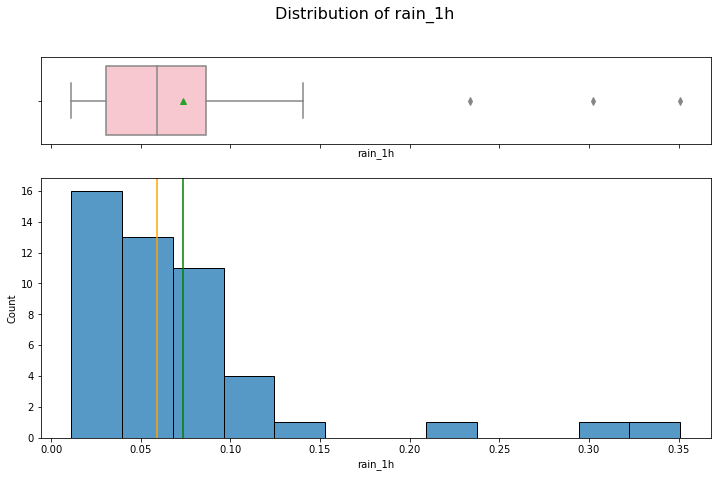
hist_box(data_month, 'rain_3h')
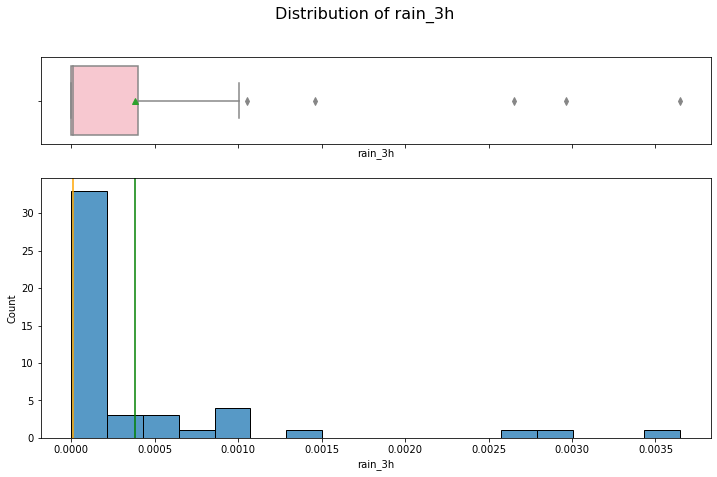
Both distributions are right skewed and contain outliers.
Snow
hist_box(data_month, 'snow_3h')

For most of the days, the quantity of snowfall is zero.
Clouds
hist_box(data_month, 'clouds_all')
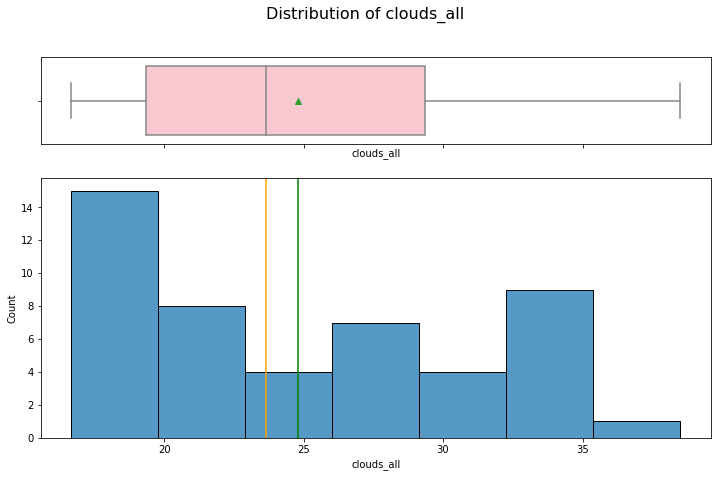
It is a right skewed distribution without outliers.
Energy Price
hist_box(data_month, 'price actual')
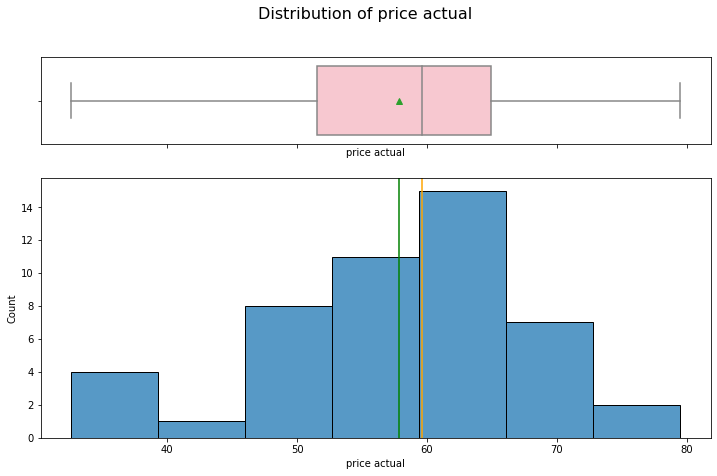
The price of the energy is left skewed with no outliers.
Pairs Plot
Let’s quickly check the scatter plot of the features with each other using the pairplot.
sns.pairplot(data_month);
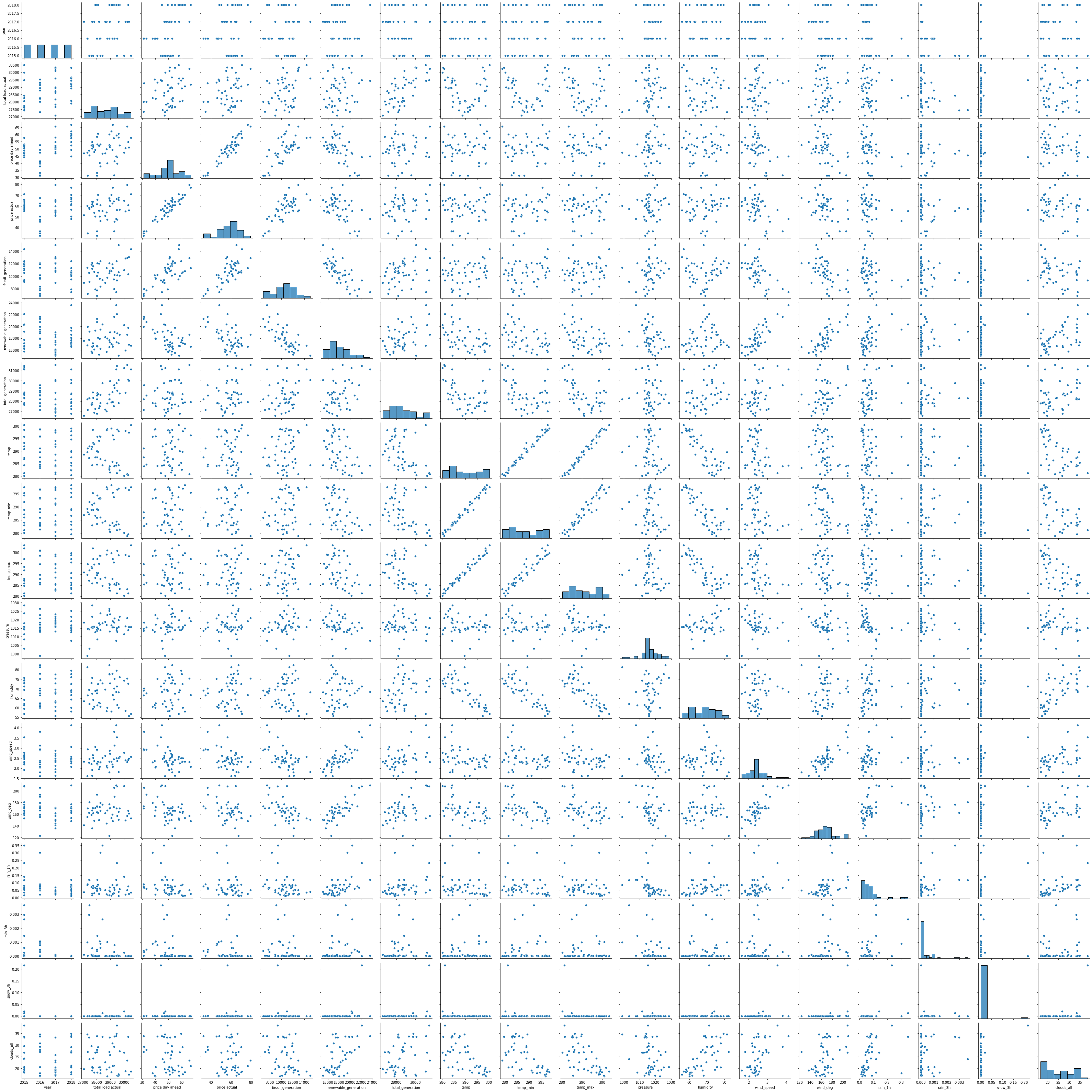
- Temperature features are highly related to each other.
- Humidity seems to have significant correlation with temperature.
- Wind speed and direction seem to influence the renewable energy production.
# Converting columns year and month to categorical
data_month["month"] = data_month["month"].astype('category')
data_month["year"] = data_month["year"].astype('category')
sns.pairplot(data_month, hue="year");
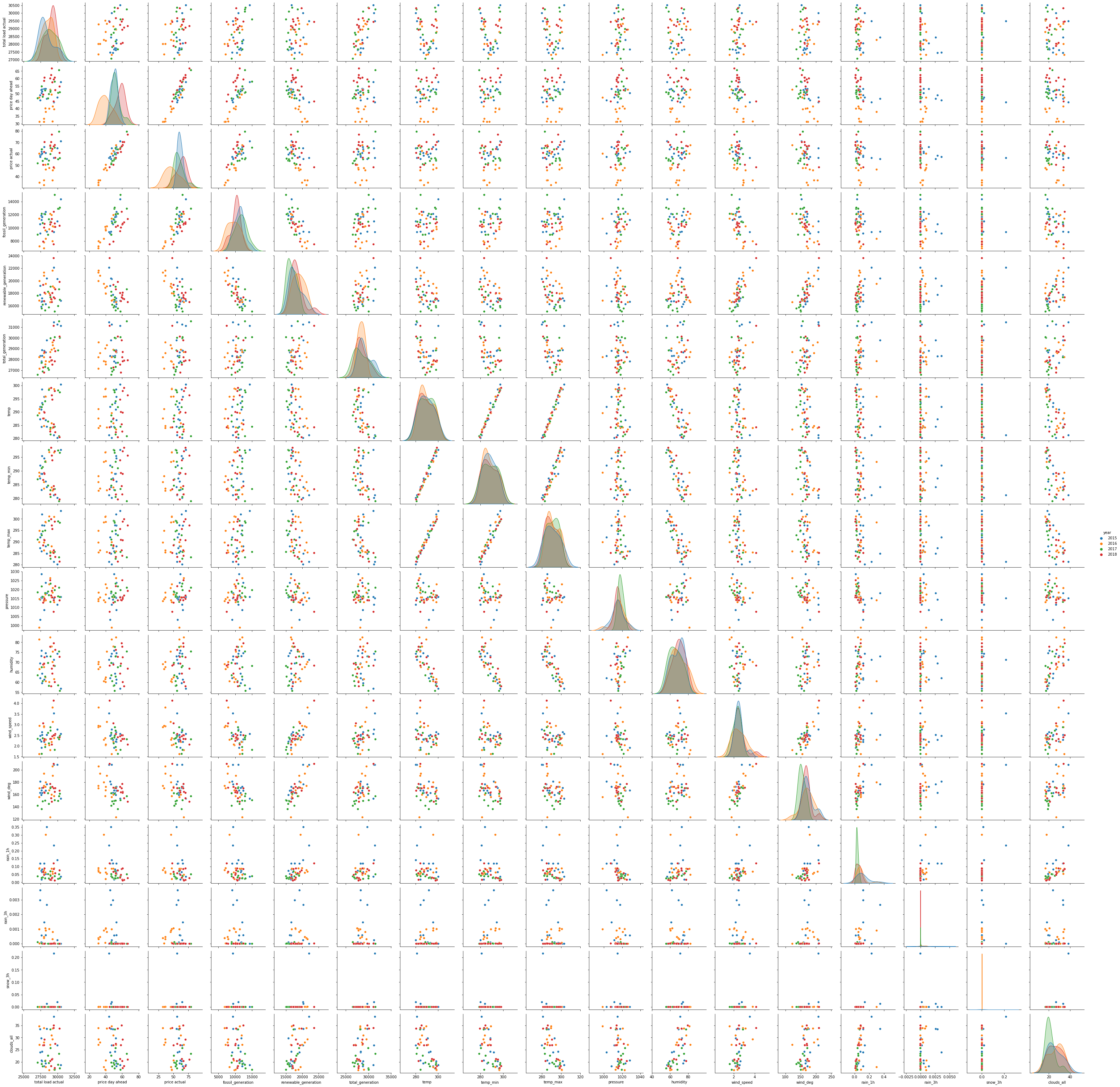
Price, load, and energy generation changes over the years.
Energy Generation in Time
Energy data
We can visualize energy generation, load, and price over the years.
plt.figure(figsize=(17, 7))
sns.lineplot(data=data, x="time", y="price actual");
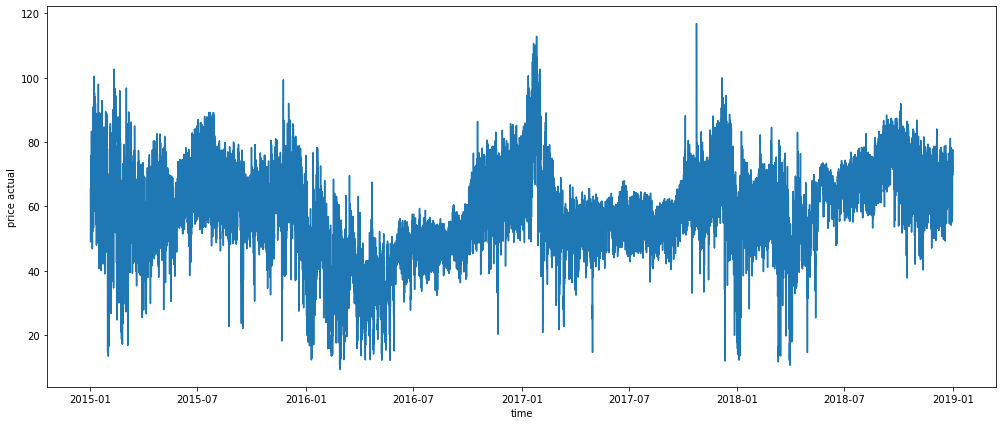
data[data['price actual'] == data['price actual'].max()]
| time | total load actual | price day ahead | price actual | fossil_generation | renewable_generation | total_generation | temp | temp_min | temp_max | pressure | humidity | wind_speed | wind_deg | rain_1h | rain_3h | snow_3h | clouds_all | year | month | |
|---|---|---|---|---|---|---|---|---|---|---|---|---|---|---|---|---|---|---|---|---|
| 24642 | 2017-10-23 17:00:00+00:00 | 31103.0 | 71.42 | 116.8 | 18599.0 | 13686.0 | 32285.0 | 295.064 | 294.55 | 295.55 | 1023.4 | 47.0 | 2.6 | 123.0 | 0.0 | 0.0 | 0.0 | 0.0 | 2017 | October |
We can see how the price of energy has changed in the dataset, with a higher peak in October 23th 2017, and a low period from January to June 2016.
plt.figure(figsize=(23, 7))
sns.lineplot(data=energy, x="time", y="total load actual");

The total load has a fairly high range (20000 to 40000), but is relatively steady over the years.
plt.figure(figsize=(17, 7))
sns.lineplot(data=energy, x="time", y="fossil_generation");
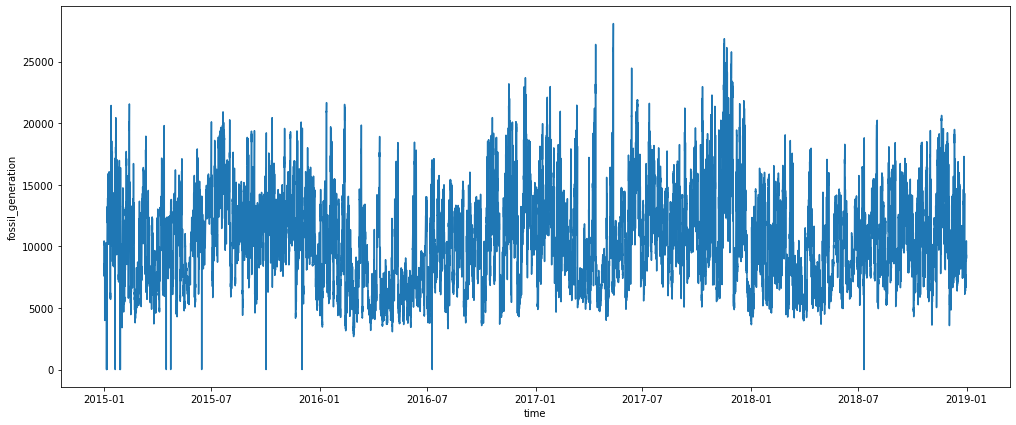
Energy from fossil sources has kept relatively steady over time.
plt.figure(figsize = (17, 7))
sns.lineplot(data = energy, x = "time", y = "renewable_generation");
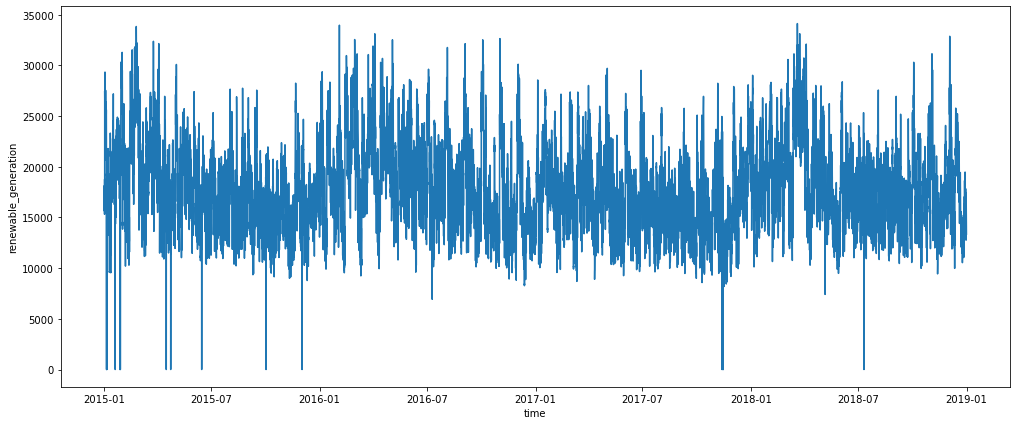
Same for the renewable energy.
Let’s now check the production, load, and price average per month and per year.
Price
plt.figure(figsize = (15,8))
sns.barplot(data = data_month, x = "year", y = "price actual");

months = ['January', 'February', 'March', 'April', 'May', 'June', 'July', 'August', 'September', 'October', 'November', 'December']
plt.figure(figsize = (15,8))
sns.barplot(data = data_month, x = "month", y = "price actual", order = months);
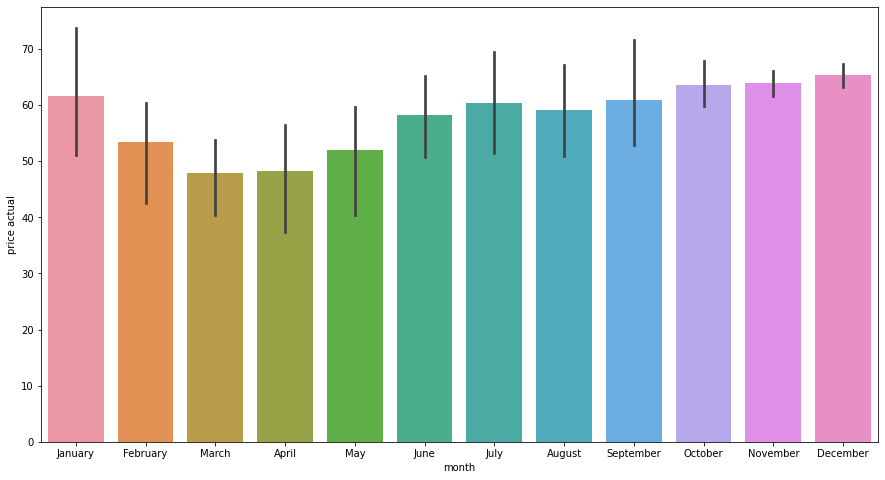
Price suffered a considerable drop in 2016, but has maintaining the same price over the years. And prices are lower by the end of Winter and during the Spring.
Load
plt.figure(figsize = (15,8))
sns.barplot(data = data_month, x = "year", y = "total load actual");
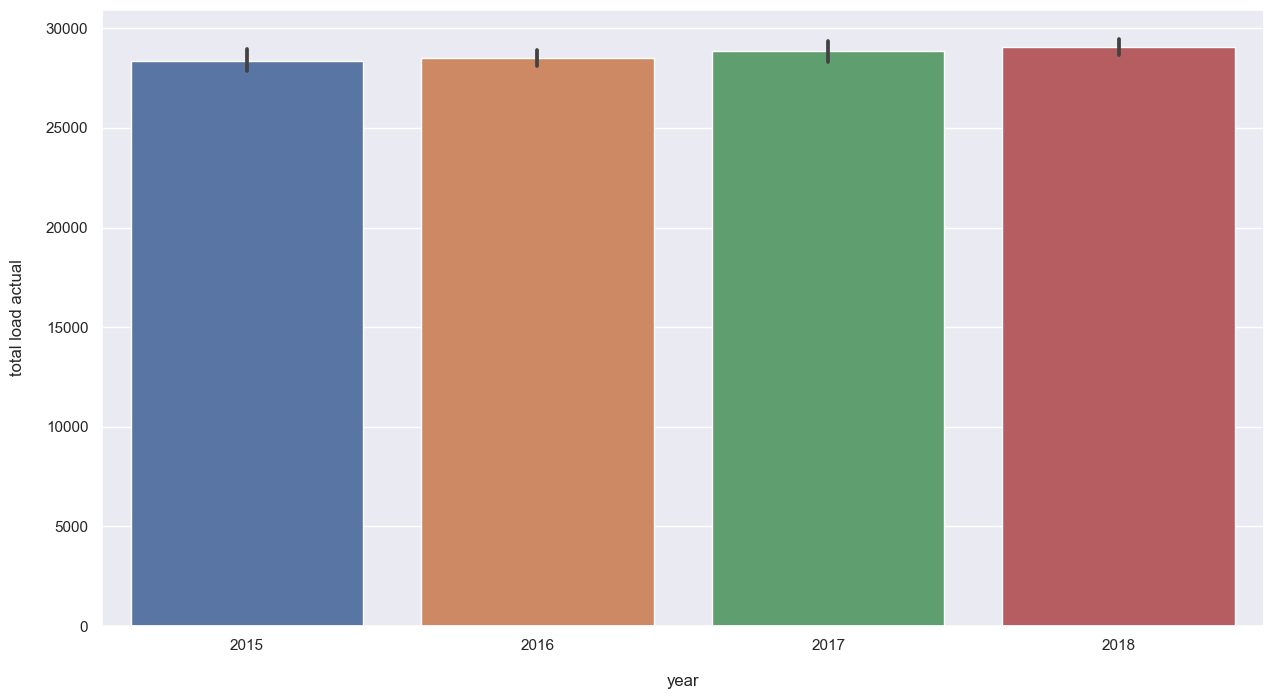
sns.lineplot(data = data_month, x='year', y='total load actual', marker='o');
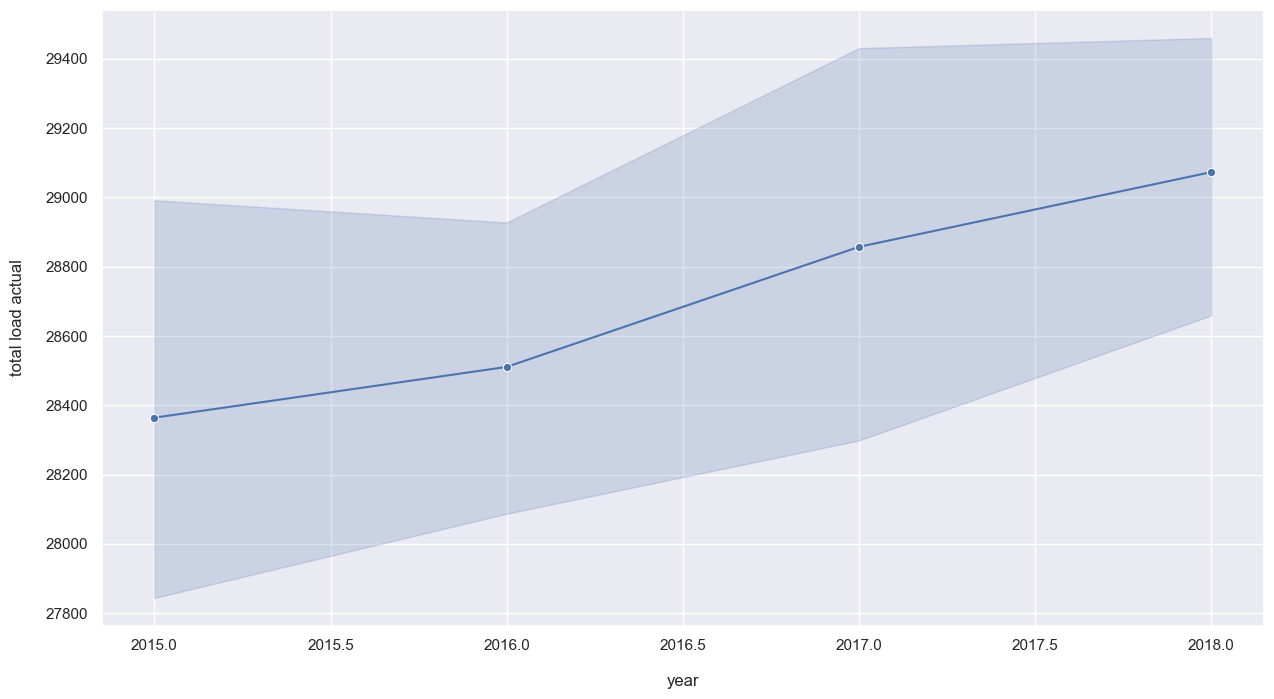
plt.figure(figsize=(15, 8))
sns.barplot(data=data_month, x="month", y="total load actual", order=months)
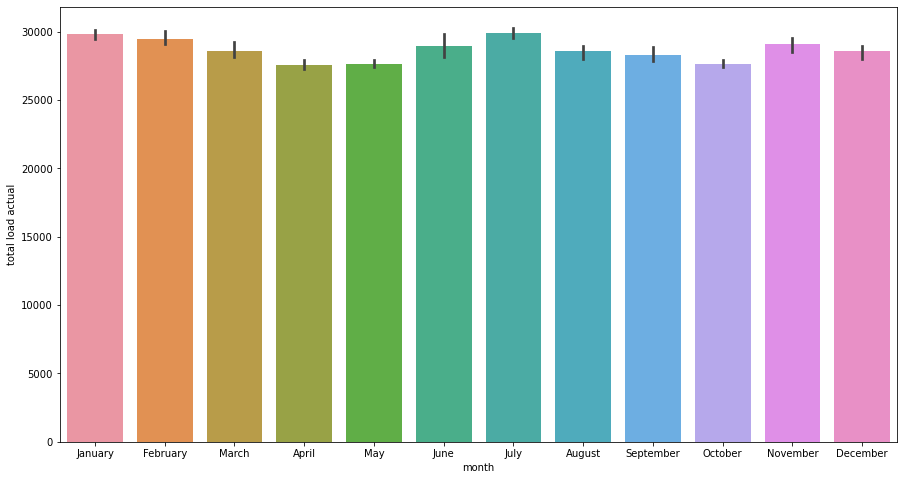
Demand for energy is slightly increasing over the years. As per months, end of Winter and Spring are the periods with lower demand of energy, which may explain the lower price during that time of the year.
Fossil Generation
plt.figure(figsize=(15, 8))
sns.barplot(data=data_month, x="year", y="fossil_generation");

plt.figure(figsize=(15, 8))
sns.barplot(data=data_month, x="month", y="fossil_generation", order=months);

Fossil generation has fluctuated over the years, and follow the same trend as price and load for the months.
Renewable Generation
plt.figure(figsize=(15, 8))
sns.barplot(data=data_month, x="year", y="renewable_generation");

plt.figure(figsize = (15,8))
sns.barplot(data = data_month, x = "month", y = "fossil_generation", order = months);
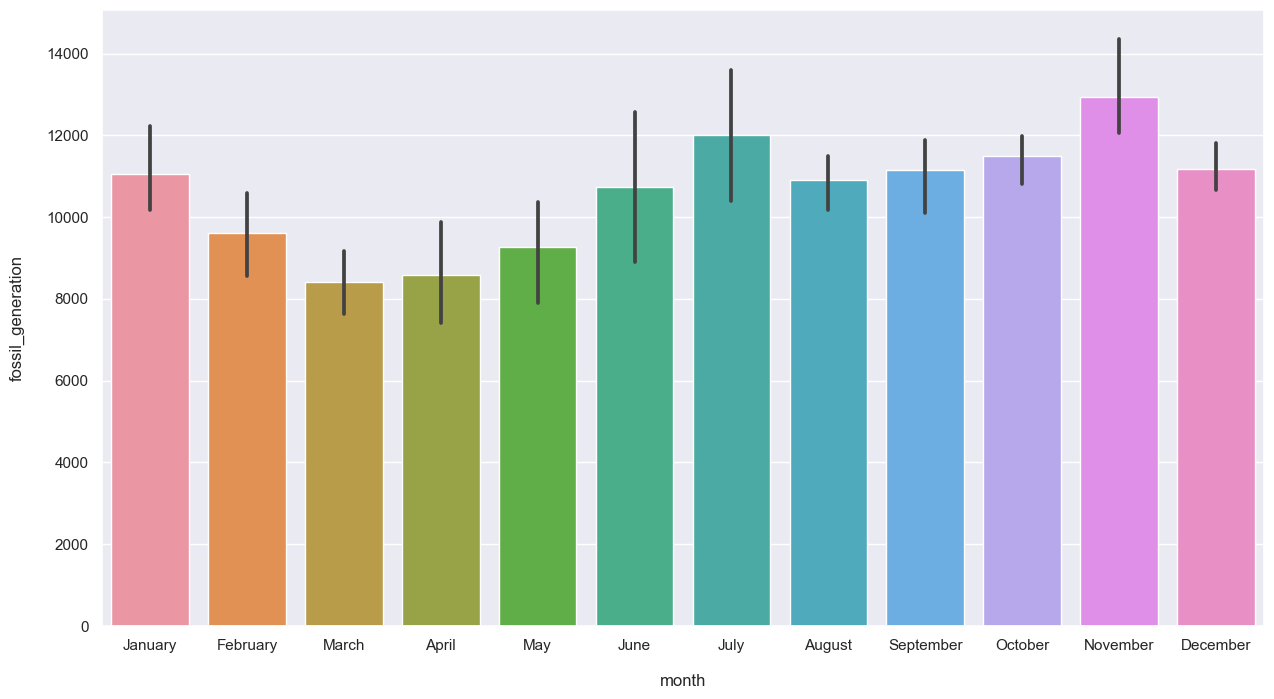
Same trend as per the fossil generation.
Summary
Insights from the analysis:
- There is a correlation between wind speed and direction with renewable energy generation
- We could find an outlier (pressure) that might be an error, and we replaced it by the average of the months from others years
- Energy demand, price, and production follow the same trend over the months, with lower valuer by the end of Winter and during Spring
- Energy demand haven’t changed much over the years
- Generation, for both fossil and renewable, fluctuate over the year
- Price had a signifcant drop in 2016, and it requires further research to learn the reason.